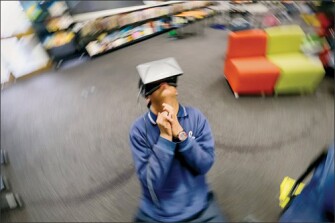
Despite a recent wave of hype, augmented- and virtual-reality tools remain fringe technologies in U.S. classrooms, according to a new survey by the nonprofit group Project Tomorrow.
Just 5 percent of U.S. teachers say they are currently using AR or VR in their classroom, the group found in its annual Speak Up survey of hundreds of thousands of students, parents, teachers and school administrators. Those numbers tick up a bit for high school science teachers (9 percent) and computer science and technology teachers (11 percent.)
“We’re still in the ‘gee-whiz’ phase,” Project Tomorrow CEO Julie Evans said in an interview.
“Things turn from being a marginal technology to something sustainable in the classroom when we start having conversations about their educational benefits and how they’re implemented,” she said.
Virtual reality generally involves a computer-generated immersive environment that users can interact with in ways that feel real. The most recent hype cycle around the technology kicked off in 2014, when social-media giant Facebook brought VR company Oculus for $2 billion and touted the educational possibilities of the company’s headset, called the Rift.
Read Education Week’s coverage of the Oculus Rift in education.
Such technology has yet to make any real headway in U.S. schools, Evans said.
“With VR, it requires another type of device, when teachers are still talking about the challenges of getting every kid an iPad or a Chromebook,” she said.
Augmented-reality technologies, meanwhile, overlay digital images and information over a user’s view of the real world. The best-known example is Pokémon Go, the uber-popular mobile app that captured the country’s imagination in summer 2016.
Read Education Week’s coverage of Pokémon Go in education.
For years, developers and researchers have been testing classroom technologies that use the same principles, including tools that can be used to enrich student field trips and apps that allow teachers to create their own augmented-reality experiences.
While the educational potential of AR is more immediately evident than for VR, it has also yet to penetrate the K-12 market, Project Tomorrow found. Just 12 percent of principals and 13 percent of teachers surveyed said they envision augmented-reality apps as part of their “ultimate school.”
Clearly, vendors will continue trying to create an educational market for such technology. Just this week, at Facebook’s annual developers conference, founder Mark Zuckerberg described the big bets his company will make on augmented reality in the coming years.
For the moment, at least, it’s hard to see the applications Zuckerberg described—digital sharks floating in your cereal bowl, for example—having much learning value in a K-12 classroom.
But from video games to mobile devices, there’s a rich recent history of new technologies getting broad adoption in the consumer sector, then getting adapted by teachers for educational contexts.
If that’s to happen with augmented reality, said Evans of Project Tomorrow, technologists will have to sit down with educators and have meaningful conversations about how fun consumer tools can be to create new kinds of educational content and new learning experiences that actually match teachers’ goals for their classrooms.
Whether that will happen remains to be seen. The new Project Tomorrow data on current usage of AR and VR in the classroom can provide a baseline.
“Maybe it started on the consumer side with Pokémon Go,” Evans said.
“From there, as teachers and parents get more familiar with it, maybe we’ll see it move across the transom.”
Photo: Aaron Gonsalves, a student at the Jackson School, a school for special-needs students in Victoria, Australia, tries out the Oculus Rift virtual-reality system.--Luis Enrique Ascui/AP for Education Week
